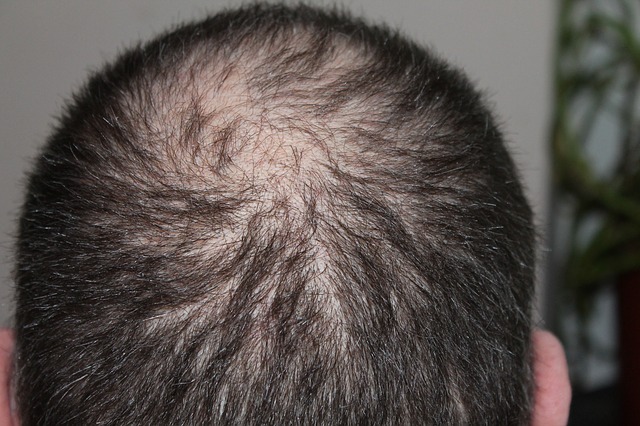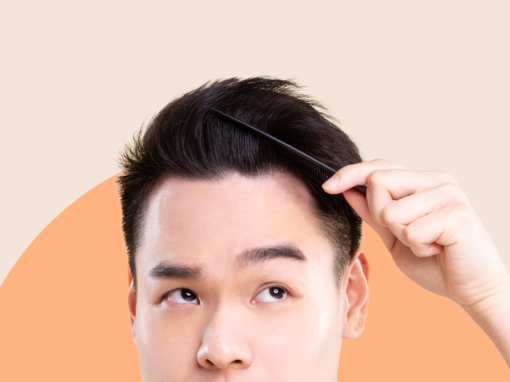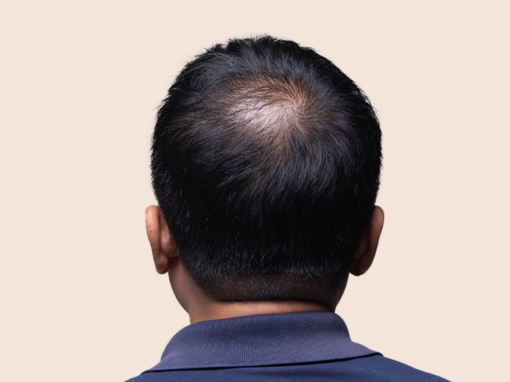Hair does play an essential role in a man’s personality. Healthy and shiny hair are not just a woman’s assets but also help a man feel more confident about his looks.
While a good percentage of men see a receding hairline post their 40s, having a premature hair loss is not uncommon. Hair loss during the early twenties can be stressful for men.
In this article, we will understand the main reasons for hair loss in men under 25.
The graph below indicates the global haircare market from 2012 to 2025.

Research has shown that more than 16% of men in their early twenties are affected by extensive or moderate hair loss.
If you are below your 30s and are experiencing mild or moderate hair loss, it is essential to get immediate medical help to stop the problem from worsening.
The article is a part of our comprehensive series on “Hair loss in men”.
What is male pattern baldness?
This is a common type of hair loss affected by men across the globe at a particular stage of their life. Male pattern baldness has a unique characteristic of M-shaped hair thinning at their scalp region.
Also known as androgenic alopecia, this problem affects more than 50% of men over the age of fifty.
Essential reasons for premature hair loss in men (in their early twenties)
Here are some reasons why men in their early twenties undergo premature hair loss:
1. Deficiency in vital nutrients
One of the common symptoms for people who have a nutritional deficiency is early hair fall.
You may experience sudden hair fall if you are deficient in essential nutrients such as iron, zinc, protein and Vitamin B12.
2. Hormones
The most commonly known form of male pattern baldness is androgenetic alopecia. This is mainly a hormonal or genetic condition in which hair loss is caused by DHT(dihydrotestosterone), a hormone derived out of male sex hormone testosterone.
It is clinically proven that people suffering from androgenic alopecia have high amounts of DHT in their bloodstream.
Some of the most commonly sought treatments for male pattern baldness are:
- Oral medications
- Laser therapy
- Hair transplant
- Plasma treatments
- Serum treatment etc.

3. Anxiety, trauma or stress
Hair loss is common among highly anxious men, who have undergone trauma or work in a stressful environment.
This type of hair loss is commonly called telogen effluvium.
This can cause a rapid loss of hair that affects the entire scalp region. Hair loss due to stress can be broadly classified into three categories:
- Alopecia areata-This problem occurs when the immune system of the body starts attacking healthy hair follicles.
- Telogen effluvium- This issue occurs when extreme stress pushes the hair follicles in the resting phase, resulting in hair loss.
- Trichotillomania is basically a psychological condition when the person has an insatiable urge to pull his hair. Excessive pulling can damage the hair follicles.
4. Lifestyle choice
Improper lifestyle is another main reason for causing hair loss. This includes smoking, consuming excessive alcohol, having irregular meals etc.
Research has indicated that sudden gain or losing of weight can also result in hair loss.
5. Physical damage to the scalp
Hair loss can also result due to the physical damage caused on hair follicles or the skin. Using hair products that contain strong chemicals or a specific hairstyling technique puts excessive stress on your scalp region, resulting in hair loss.
6. Improper hair care
Hair loss is common in people who do not give proper attention to hair care. Ensure that you clean your hair with shampoo at least twice every week to remove all the pathogens, oil and dirt.
While cleaning, make sure not to use strong shampoos and avoid excessive rubbing as it may damage the hair follicles.
7. Side effects of certain medicines
Hair loss is also caused by certain medications such as chemotherapy, beta-blockers, amphetamines, and anticoagulants. But these effects are mostly temporary and can be reversed quite easily.
Chemotherapy, the most popular cancer treatment for cancer, also causes hair loss but

What are the risk factors for hair loss?
Here are some of the commonly known risk factors for hair loss.
1. Family history
If you are facing hair loss in your early twenties, the genes you inherit from your ancestral lines could be one of the reasons.
2. Sudden variations in weight
People who have sudden fluctuations in weight tend to experience more hair loss. In some cases, the underlying issue is due to improper functioning of the thyroid gland, which will cause weight fluctuations and weakening of hair follicles resulting in hair loss.
3. Stressful work situations
Young adults who are working under highly stressful situations are more prone to male pattern baldness.
Preventive methods and treatment options for hair loss for men in early twenties
Young men are sometimes so confident about their hair that they ignore the warning symptoms of hair loss. Unfortunately, when they finally come to realize the problem, it gets a little late for reversing the problem.
Some time tested and proven methods for hair loss prevention tips include:
- Avoid pulling your hair unnecessarily
- Consuming a well-balanced diet
- Avoid rubbing your hair vigorously
- Use a broad toothed comb
- Avoid harsh chemicals and hair treatments
Following are some effective treatment methods for battling hair loss in men in their early twenties.
1. Medications for hair loss
The most commonly used medication for treating hair loss is:
- Finasteride (Propecia) and
- Minoxidil (Rogaine)
Finasteride
The medication was initially developed for treating prostate cancer, but it was later discovered that finasteride helps to reduce the amount of DHT hormone, causing hair loss.
DHT causes shrinkage of hair follicles resulting in hair loss. Thus cutting down the amount of DHT in the bloodstream will help reduce hair loss.
Finasteride is commonly used to treat male pattern baldness appearing in the crown portion of the head.
Minoxidil
Minoxidil was initially developed with the intent of treating high blood pressure. However, later it was found that the drug causes hair growth, which is why it is used to treat male hair loss.
This drug directly influences the hair follicles causing them to grow thicker and more robust. Minoxidil also helps prolong the hair growth phase, helping to develop a large number of hair strands.
Minoxidil is applied externally in the scalp region in most cases, as oral consumption will result in unwanted hair growth at different parts of the body.
2. Natural ingredients for hair loss treatment
Research has indicated that collagen powder supplement helps to improve the growth of new hair follicles helping in treating hair loss. Therefore, it is best to regularly include collagen powder supplements in your diet for the best results.
Similarly, Biotin tablets can help to boost hair growth.
Another natural ingredient is Saw Palmetto which is a native American herb. Its extracts have the power to stop the conversion of testosterone to DHT. With this, it is possible to reverse hair loss in men as DHT is mainly responsible for hair loss in men.
Check out the thickening shampoo with natural ingredients.
3. Laser comb treatment
This is typically a modern treatment in which concentrated laser beams are shown on the top of the scalp to stimulate hair growth.
Research has proven that laser comb treatment helps to produce thicker and stronger hair. Therefore, this method is often combined with other forms of treatments to achieve quick results.
4. Hair transplant surgery
In this method, hair follicles that are DHT resistant and are located in the back portion of the head are removed and surgically implanted in the frontal areas.
This technique helps to give visible changes to the hair loss areas.
5. Hair loss therapy
This is a combination treatment that involves various treatments such as hair loss medications, creams, conditioners, laser treatment etc.
Check out various hair loss treatment solutions and plans available at Andsons Singapore.
Bottom Line
Hair loss can be harrowing for young adults in their early twenties. In this article, we have discussed various factors that cause premature hair loss starting from genetic reasons to reactions to certain medications.
You could also try out the natural hair loss remedies that could help stimulate hair growth before opting for medications.
Medical professionals often say that patients seek treatment for hair loss only when the problem has progressed to a greater extent.
If you are below 30 and experiencing high or moderate hair loss, timely medical intervention can help arrest or reduce progress speed.
References
Elise A Olsen,Frank E Dunlap,Toni Funicella,Judith A Koperski,James M Swinehart,Eduardo H Tschen,Ronald J Trancik(3 Sep 2002)A randomized clinical trial of 5% topical minoxidil versus 2% topical minoxidil and placebo in the treatment of androgenetic alopecia in men, Available at https://pubmed.ncbi.nlm.nih.gov/12196747/ [Accessed 6 Nov 2021]
Evyatar Evron,Margit Juhasz,Arash Babadjouni,Natasha Atanaskova Mesinkovska(23 Aug 2020)Natural Hair Supplement: Friend or Foe? Saw Palmetto, a Systematic Review in Alopecia, Available at https://pubmed.ncbi.nlm.nih.gov/33313047/ [Accessed 6 Nov 2021]



